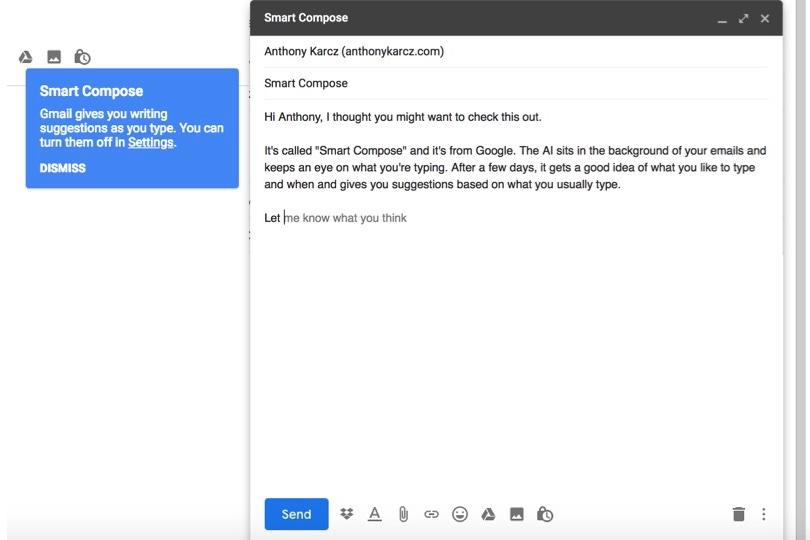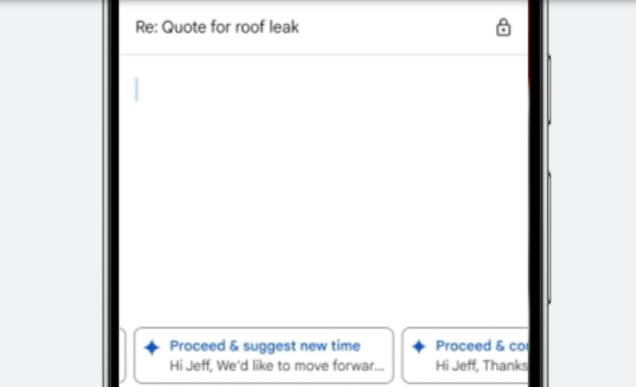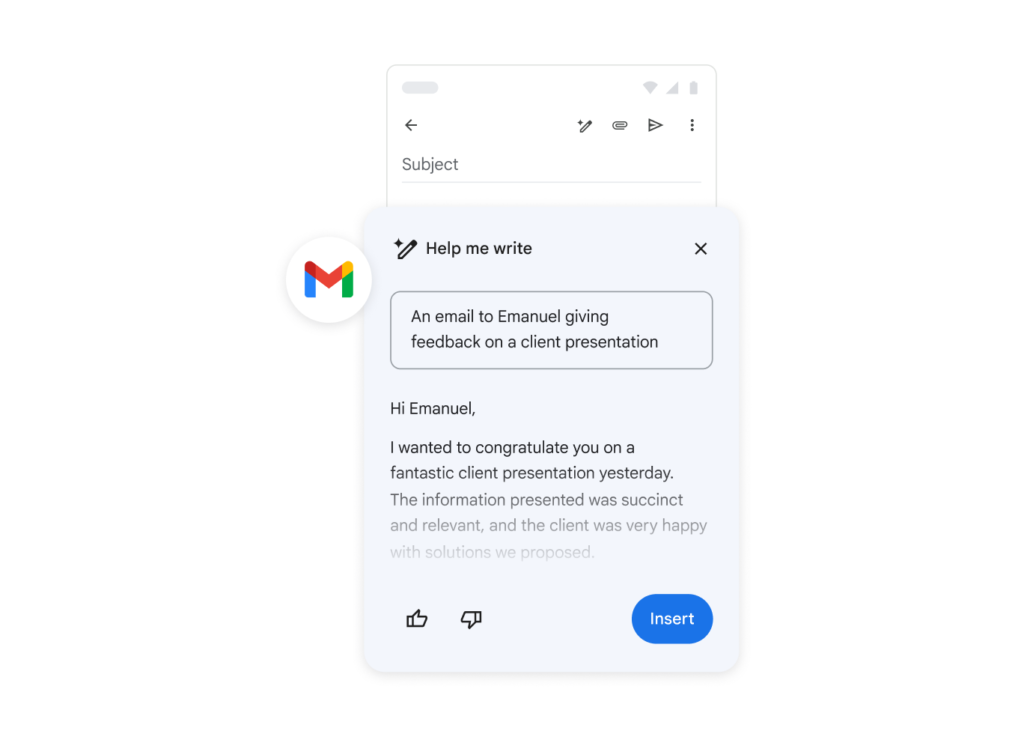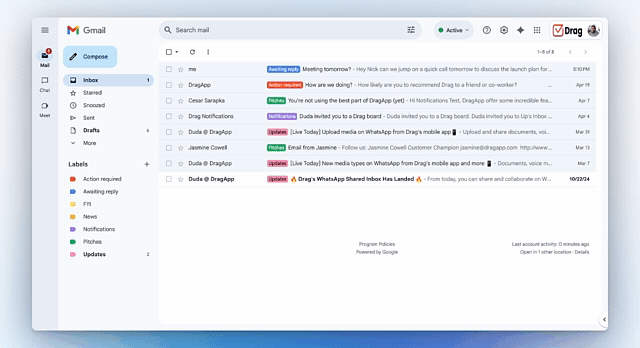AI email replies have slowly become a part of standard email usage. From quick acknowledgements and autocorrect suggestions to complete messages, users can now deal with their inboxes much faster with AI integrations. These tools help save time, stay productive, and keep up with higher volumes of emails.
But how do AI email replies work? What are the best use cases for them and where should they not be used? In this article, we’ll break down the basics AI in email, explore its pros and cons, and share some industry cases to help guide your decision and find the ideal method for your workflow.
Read more to learn how AI is rewriting the way we send emails!
What are AI email replies?
AI email replies are automated message suggestions based on the content of the original message. Generative AI tools use machine learning algorithms to draft a reply based on the context.
There are two main ways AI does this. The first one is by autocompleting and autocorrecting your writing. On Gmail, for instance, you can set up Smart Compose, a built-in tool that gives you quick suggestions on how to end your messages:

source: Forbes
As AI tools and resources became more reliable, however, users are now able to both prompt them and get quick suggestions directly on their inbox or by using chatbots. That’s the case for Gmail:
Do AI email replies help productivity?
Yes, AI email replies can go a long way by helping users deal with cluttered inboxes. Most professional email users have multiple ongoing threads, whether it’s with customers or colleagues. That means having a good system that suggests quick options saves them time spent on crafting replies.
How? Here are a few scenarios in which AI email replies are a helpful tool:
-
Frequently asked questions: AI email replies save time by suggesting faster responses to routine or repetitive emails;
Example: AI tools can help team members respond with a single click to meeting invites or project status updates -
Workload balancing: Users can focus on more complex or strategic messages instead of drafting every reply;
Example: Sales teams can use AI drafts to build B2B outreach strategies, then manually write individual replies to potential leads -
Response time metrics: in high-volume environments like customer support or sales, AI can speed up response times and streamline workflows;
Example: Customer service teams can offer clearer replies to their clients and improve their solution rates and workaround time with a less cluttered inbox -
Tone and branding: by matching the suggestions to your prompts and context, AI email replies can help you build your brand voice according to the company’s needs and audience profile;
Example: Marketing teams can use AI to adjust their replies based on different audience segments or tone demands -
AI as an assistant: beyond automated replies, AI can be applied as a primary inbox filter;
Example: Professionals implement AI tools that categorize their emails and help them pay closer attention to the ones that require extra focus and time, while automating low-priority and repetitive messages
When can you use AI email replies?
There’s multiple areas in which AI email replies are useful, both for entrepreneurs and teamwork. You can take advantage of AI email drafts and suggestions to clear your inbox much faster on different company workflows, including:
Marketing
According to research conducted by Ascend2, 92% of marketers say AI-driven tools have improved their A/B testing processes. The Future of the Martech Stack 2025 says that the main concerns these professionals use AI tools for are content personalization and audience targeting.
And yes, most marketing teams can benefit from AI email tools for their campaigns. For example:
- Adapting emails to different segments: when writing a reply to potential customers to direct them to your website, use AI to get custom suggestions based on demographics and product specs.
Prompt example: Write an approchable and professional email reply to a potential customer who asked for more information about our B2B services. The customer is a UK-based small business owner in retail, and is interested in improving their team’s productivity. Mention how our solution adds to their tech stack, highlight our flexible plans, and include a CTA to our website for more details.
- Customer feedback and market research: after conducting a feedback campaign or opening up a feedback channel, marketing teams can use quick AI email replies to thank participants for their opinions and let them know it’s been taken into account.
Prompt example: Write a professional email reply with a warm tone, thanking a customer for completing our product feedback survey. Acknowledge that their input is key for our further development and will be reviewed by our team. Keep it to 150 words and mention that we’re always open for follow-ups if they’d like to discuss further.
IT and customer support
Customer service teams can also benefit from AI email replies, especially because they tend to receive the highest volume of emails. With that in mind, two of the main scenarios for quick replies are:
- TBD: Letting the customer know their query has been received and is currently on the waitlist
Prompt example: Compose a quick reply thanking the customer for being patient and letting them know our support team is reviewing their concern and will get back to them ASAP. Use an approchable, apologetic tone.
- Answering FAQs and directing the recipient to a support knowledge base
Prompt example: Write a clear message to a customer inquiring about [error], including the explanation detailed in [guide] and include a link to our FAQ and troubleshooting page. Include apologies for errors and let them know they can reach out if they have any further questions.
Sales outreach
Automation and AI can optimize the sales pipeline as well. Here’s how:
-
Follow-ups: engaging and re-engaging potential leads after a certain period
Prompt example: Write a friendly and professional email reply to a new lead who requested help from our product team. Thank them for their interest and include the highlights of [product] a link to schedule a call.
-
Personalization: some AI tools can use CRM data to help your sales team draft better email replies including custom information
Prompt example: Draft a reply to a potential client in the healthcare industry who asked about internal chat features of [software]. Mention how our product fits their industry needs and legal requirements while including a subscription tier comparison
-
Handling FAQs: sales representatives also deal with repetitive concerns, and AI can help
Prompt example: Reply to a customer who has pricing concerns with our service. Focus on the value our product can add to their workflow and insert use cases related to [field]. Add a list of benefits in relation to their current system and a link to our payment plans and discounts
Appointment scheduling
AI email replies can also be a huge help for executive assistants, office managers, hospitality teams, and other admin professionals who handle high volumes of logistical communication.
-
Scheduling meetings
Prompt example: Draft a short email reply confirming a meeting for next Tuesday at 2 PM. Include the calendar link and offer to reschedule if needed.
-
Booking confirmation
Prompt example: Generate a message confirming a hotel reservation with check-in times and rules. Include details and offer to assist with any changes if needed.
-
Responding to invitations
Prompt example: I need a reply politely declining a conference invitation due to a scheduling conflict. Include a thank-you to the team and apologies for not being able to help. Let them know I’ll be available for future opportunities
-
Confirming appointments
Prompt example: Create a short, professional email confirming the patient is scheduled for a visit next week on Tuesday, at 2PM.
🚫 What should you not use AI email replies for?
Sure, AI email replies are useful, but there are some areas in which they shouldn’t be employed.
Sensitive data
Users shouldn’t use AI tools to send messages including sensitive information about their products, services, or the company’s strategy, especially when using free, open-source AI chatbots.
Data that includes personal information can violate privacy laws, such as GDPR and HIPAA, if the AI stores it for further machine learning. Beware of the specifics before implementation.
Technical information
If you’re sending emails with detailed technical information about your products and services or updating your team on ongoing projects, it might not be a good time for AI. That’s because these tools can give you the basics, but they aren’t reliable for specific data.
If you rely completely on AI email drafts for this, it can lead to misinformation or incomplete conversations, which creates gaps in internal and external communication.
Legal or employment concerns
AI is not a substitute for emails that require empathy and legal awareness. Using it to respond to employee complaints, terminations, or legal claims risks liability issues. The same applies to customer-facing legal emails and threads with your finance or legal teams.
Messages that rely on individual tone
Generative tools can misunderstand tone or offer inappropriate wording. That means, when writing apologetic and personal support emails, it’s crucial to draft them yourself to have the right connection to the recipient.
Cultural and social bias scenarios
Another scenario in which AI falls short is bias. Due to machine learning input and limitations, AI is notorious for having issues with cultural awareness and social bias. With that in mind, if you’re writing emails that require extra attention on multiple points of view, languages, and cultural backgrounds, AI email replies won’t be the best.
It’s worth noting that regardless of the theme or area of your emails, over-reliance on automation for all communication can create issues. Yes, AI email replies can help you get through your messages fast, but it’s important to filter out what requires extra verification and personal reflection.
The ideal compromise is having guardrails before you hit send. Check your automated reply rules, review important messages for errors and, of course, make sure you’re fulfilling the recipient’s expectation. That way, you can mantain trust and keep up with your professional email response times.
How to improve AI email replies in steps
To get the most out of AI email replies, you need more than just the right tools. The best strategy is a clear plan. Here’s how to ensure your drafts are accurate, relevant, and effective:
1) Define the email’s purpose
Before generating any content, decide what the email is meant to do: inform, engage, or convert. A clear objective will help guide the tone, structure, and call to action of the reply, making your message more focused on the end goal.
2) Know your target audience
Understanding who you’re writing to is key. Consider details on the recipient(s), such as industry, role, location, past interactions, and preferences. This type of tailoring makes the content more engaging.
3) Write great AI Prompts
The quality of AI email replies depends heavily on the prompt itself. Vague guidelines lead to vague output. Be specific about tone, audience, and intent.
-
Weak: “Write an email about our seasonal sale.”
-
Strong: “Write an email with a friendly tone to our small business owner customers, letting them know we’re running our yearly sale on service subscription. Mention how our service has helped similar clients in the past and detail the payment conditions. Let them know our team is open to any questions if they need help.”
4) Combine automation and customization
AI speeds up drafting, but custom emails increase impact rates. Add industry-specific details for each audience segment and include dynamic fields like names or company roles (based on your CRM data), and refer to previous interactions to make your message feel more compelling.
5) Review and edit
Emails created by AI are quicker, but they still need a human touch. Always proofread for clarity, correct tone, and accuracy. Make sure the message is aligned with your brand voice and compliant with any legal or ethical requirements.
Getting started with AI email replies
Now that you know the benefits, limitations and how to get the best out of AI email replies, here are the main methods to start implementing them:
1) Chatbot prompts
Users can use the LLM chatbot of their preference to prompt for AI email replies. Just open up a new window and type in the type of email draft you need:
The pros of this method are that there’s no installation required, all you need to do is access the chatbot itself. Plus, these platforms have free limited plans that are useful for most people.
The cons are that you don’t have automation or cross-platform features. Instead, users need to manually copy and paste the generated AI drafts into their emails.
If you don’t receive a high volume of emails regularly, this option may work well for your needs.
2) Gemini in Gmail
Gmail’s own Gemini AI assistant is already built into the inbox itself. Google Workspace users have smart compose options and suggestions directly in their message windows, along with other useful tools like thread summaries and inbox context search.
The advantage is that you can use the space you’re already familiar with, so the learning curve is easier. Besides, Gemini learns from your inbox history, so the suggestions are tailored to your previous interactions.
The biggest con is that if you need more advanced tools, such as integration with other Google Workspace tools like Google Sheets, you need to invest in paid Workspace subscriptions, starting at $14/user/month. Also, most resources are limited to one inbox, so if you’re managing multiple addresses, the automation won’t include them all.
This method can be useful for small teams that need CRM capabilities along with their digital workspace.
3) Dedicated AI email clients
Specialised AI-driven email services are a possibility when implementing AI email replies. Tools like Superhuman AI are built to offer multiple AI functions directly into your email.
The benefits are that you get more custom options in comparison to Gmail itself, which can be needed depending on your team’s workflow. Plus, different tools have different payment tiers, so users can pick one that fulfills their needs without any feature bloat and overpriced subscriptions.
However, using a new email client has its cons as well. First of all, it doesn’t sync with your drafts folder, which can break your workflow. Plus, each tool is limited to the AI model it’s built on (in Superhuman’s case, OpenAI). Another disadvantage of using an external email client is that they aren’t compatible with other Gmail extensions, so if you rely on them, they may not work well.
3) AI email assistant
An AI email assistant, however, is a customizable option for users who need AI email replies and much more that AI automation can offer. Our solution, Hey Help, is a powerful (and flexible) option for teams that work on multiple areas and require a high level of automation to turn their inbox into a productive workspace.
Hey Help enhances the inbox experience by:
- Sorting emails: it automatically does an inbox triage and categorizes emails based on urgency, priority, and subject. Using archiving and labels, Hey Helps gives you a cleaner space to work with and guidelines to help you schedule your workflow better.
- Drafting replies: after your inbox is sorted, Hey Help drafts custom replies based on the tone and context of the message, aligning them to your specific communication needs. When you want to reply, all you have to do is edit and click send.
- Context learning: the biggest benefit of Hey Help is that it learns from your inbox use patterns. That is, with time, it improves suggestions and filters based on how you interact with your inbox and adapts to your writing style and tone. That way, messages are tailored to your and your audience’s needs.
An AI assistant like Hey Help is built into Gmail. That way, you don’t have to learn a new platform or let go of any additional extensions you use on a daily basis. Instead, it improves the workspace of multiple areas and inboxes by integrating Gmail to other parts of your workflow, which helps teams collaborate.
Beyond that, Hey Help allows users to benefit from the AI model of their choice instead of relying on one LLM individually.
Hey Help is available with a lifetime access for $129
AI email replies methods: a comparison
| Chatbot | Gemini in Gmail | Dedicated AI Email Clients | Hey Help | |
|---|---|---|---|---|
| Platform | External LLM window | Built into Gmail | Separate email client (e.g., Superhuman, Notion Mail, Fyxer) | Gmail-based extension |
| Setup | None | None (built into Google Workspace accounts) | Requires new software installation | One-time setup and sync |
| Automation | Manual process | Limited to quick suggestions | High, but limited sync with Gmail | Full: triage, draft and autotagging |
| Integration with Gmail | Not integrated | Native | Partial | Full (uses Gmail and supports extensions) |
| Context awareness | None | Learns from inbox history | Varies by tool of choice | Advanced inbox context learning and adaptation |
| Multi-inbox support | Available manually | Limited to one inbox | Software and subscription plan-dependent | Supports multiple workflows |
| Flexibility | Prompts can be customized and edited | Limited, results can be generic | Medium to high (program-dependent) | High (supports multiple LLMs and workflow integration) |
| Price | Free (basic use) | Starts at $14/user/month (Workspace) | Varies by tool, monthly subscription plans | $129 lifetime access |
| Best for | Occasional users needing free AI email replies | Small teams using Google Workspace | Data-driven users requiring built-in AI workflows | Teams needing scalable automation and multi-use inboxes |
Conclusion
AI email replies are quickly becoming an essential tool in digital communication for professionals. Simple chatbot prompt, Gmail’s built-in AI, and fully automated processes like Hey Help are good solutions that can match your requirements.
The key is understanding where and how AI can support your email use without relying on replicating or replacing specialised work. By automating repetitive replies, managing inbox volume, and personalizing tone and content, AI email tools boost productivity while saving time and resources for complex tasks and customized communication strategies.
No matter your role, there’s a practical and scalable AI email reply solution that can transform how you work, as long as you pay attention to privacy, tone sensitivity, and content clarity to get the best out of these platforms.
Frequently Asked Questions: Using AI for Email Replies
How do AI email replies work?
AI email replies use machine learning to analyze incoming messages and generate relevant, context-based responses. This can happen through autocomplete tools like Gmail’s Smart Compose, or through advanced AI models that draft full replies based on prompts, tone, and user patterns.
Why is it important to review and edit AI email replies before sending?
Reviewing and editing AI email replies is key for maintaining professionalism, accuracy, and voice consistency. While AI can generate fast drafts, it may misinterpret tone, miss context, or include incorrect information. Reviewing provides a reliable response, especially in sensitive or complex conversations.
What is the best AI email reply tool for Gmail users?
The best AI email reply solution for Gmail users depends on your needs. Gemini is ideal for built-in, basic suggestions, while Hey Help offers advanced features like inbox triage, custom replies, and cross-inbox management in Gmail’s interface as an extension.
Can AI email replies be personalized for different audiences?
Yes, AI email replies can be customized based on recipients. With detailed prompts, context learning, and integration with CRM tools, AI assistants can draft responses tailored to demographics, industry, previous interactions, and user preferences, increasing open and engagement metrics.





